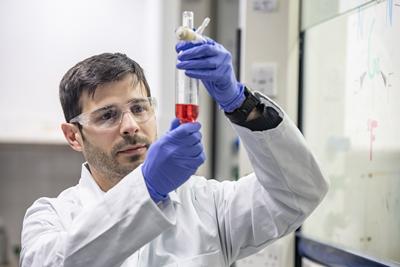Chemistry Doctoral Prize explores new radiotracers for improved medical imaging

Multi-disciplinary research at the University of Southampton is developing metal fluoride complexes which will enable higher-quality medical imaging scans for the diagnosis of diseases.
Dr Francesco Monzittu, from the School of Chemistry, is investigating new positron emission tomography (PET) radiotracers through a Doctoral Prize from the Engineering and Physical Sciences Research Council (EPSRC).
Working closely with project partners at King’s College London (KCL) and GE Healthcare, he is synthesising new radioactive compounds that could improve the images from PET scans, of which hundreds of thousands are produced in UK hospitals every year.
PET imaging visualises internal organs by injecting patients with a molecule bearing a radioactive element whose decay and subsequent annihilation produces photons visible to specialist camera technology. The fluorine-18 isotope used in this work has a decay half-life of under two hours, making fast and efficient preparation of the tracer essential.
“Fluorodeoxyglucose, [18F]FDG, is the most commonly used PET radiotracer currently, but its lack of selectivity can be detrimental for the detection of tumours at an early stage,” Francesco explains. “A new generation of PET tracers that incorporate 18F into molecules that target protein receptors specifically expressed at the surface of diseased cells would potentially provide earlier and more informative diagnoses. This improved selectivity and quality of images could provide very valuable information to surgeons and consultants and ultimately have a major, positive impact on patients.”
The one-year Doctoral Prize project builds upon results obtained in Francesco’s PhD at Southampton, which explored new transition and main group metal complexes that form strong M-F bonds for the incorporation of 18F into new inorganic PET imaging agents.
“Our aim is to synthesise metal complexes that have a very high affinity for 18F- ions, allowing very fast and efficient radiolabelling, and to couple these to a specific biomolecule that will deliver the 18F to the part of the body of interest, such as the surface of diseased cells,” Francesco says.
The multi-disciplinary approach brings together synthetic inorganic chemistry, biochemistry and nuclear medicine techniques, making use of specialist research facilities in Southampton and St Thomas’ Hospital in London.
“This is challenging research, but it holds great potential” Francesco says. “We hope that it can lead to the development of new products and technologies that will benefit patients, the NHS and the UK economy.”